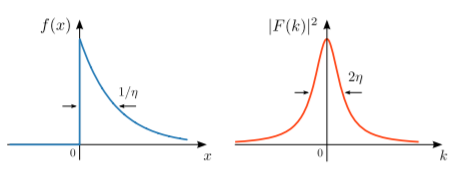10.2: Fourier Transforms
( \newcommand{\kernel}{\mathrm{null}\,}\)
The Fourier series applies to periodic functions defined over the interval −a/2≤x<a/2. But the concept can be generalized to functions defined over the entire real line, x∈R, if we take the limit a→∞ carefully.
Suppose we have a function f defined over the entire real line, x∈R, such that f(x)→0 for x→±∞. Imagine there is a family of periodic functions {fa(x)|a∈R+}, such that fa(x) has periodicity a, and approaches f(x) in the limit a→∞. This is illustrated in the figure below:

In mathematical terms, f(x)=lima→∞fa(x),wherefa(x+a)=fa(x). Since fa is periodic, it can be expanded as a Fourier series: fa(x)=∞∑n=−∞eiknxfan,wherekn=nΔk,Δk=2πa. Here, fan denotes the n-th complex Fourier coefficient of the function fa(x). Note that each Fourier coefficient depends implicitly on the periodicity a.
As a→∞, the wave-number quantum Δk goes to zero, and the set of discrete kn turns into a continuum. During this process, each individual Fourier coefficient fan goes to zero, because there are more and more Fourier components in the vicinity of each k value, and each Fourier component contributes less. This implies that we can replace the discrete sum with an integral. To accomplish this, we first multiply the summand by a factor of (Δk/2π)/(Δk/2π)=1: f(x)=lima→∞[∞∑n=−∞Δk2πeiknx(2πfanΔk)]. (In case you’re wondering, the choice of 2π factors is essentially arbitrary; we are following the usual convention.) Moreover, we define F(k)≡lima→∞[2πfanΔk]k=kn. In the a→∞ limit, the fan in the numerator and the Δk in the denominator both go zero, but if their ratio remains finite, we can turn the Fourier sum into the following integral: f(x)=∫∞−∞dk2πeikxF(k).
The Fourier relations
The function F(k) in Eq. (???) is called the Fourier transform of f(x). Just as we have expressed f(x) in terms of F(k), we can also express F(k) in terms of f(x). To do this, we apply the a→∞ limit to the inverse relation for the Fourier series in Eq. (10.1.13): F(kn)=lima→∞2πfanΔk=lima→∞2π2π/a(1a∫a/2−a/2dxe−iknx)=∫∞−∞dxe−ikxf(x). Hence, we arrive at a pair of equations called the Fourier relations:
Definition: Fourier relations
{F(k)=∫∞−∞dxe−ikxf(x)(Fourier transform)f(x)=∫∞−∞dk2πeikxF(k)(Inverse Fourier transform).
The first equation is the Fourier transform, and the second equation is called the inverse Fourier transform.
There are notable differences between the two formulas. First, there is a factor of 1/2π appears next to dk, but no such factor for dx; this is a matter of convention, tied to our earlier definition of F(k). Second, the integral over x contains a factor of e−ikx but the integral over k contains a factor of eikx. One way to remember which equation has the positive sign in the exponent is to interpret the inverse Fourier transform equation (which has the form of an integral over k) as the continuum limit of a sum over complex waves. In this sum, F(k) plays the role of the series coefficients, and by convention the complex waves have the form exp(ikx) (see Section 6.3).
As noted in Section 10.1, all the functions we deal with are assumed to be square integrable. This includes the fa functions used to define the Fourier transform. In the a→∞ limit, this implies that we are dealing with functions such that ∫∞−∞dx|f(x)|2exists and is finite.
A simple example
Consider the function f(x)={e−ηx,x≥00,x<0,η∈R+. For x<0, this is an exponentially-decaying function, and for x<0 it is identically zero. The real parameter η is called the decay constant; for η>0, the function f(x) vanishes as x→+∞ and can thus be shown to be square-integrable. Larger values of η correspond to faster exponential decay.
The Fourier transform can be found by directly calculating the Fourier integral: F(k)=∫∞0dxe−ikxe−κx=−ik−iη. It is useful to plot the squared magnitude of the Fourier transform, |F(k)|2, against k. This is called the Fourier spectrum of f(x). In this case, |F(k)|2=1k2+η2.

The Fourier spectrum is shown in the right subplot above. It consists of a peak centered at k=0, forming a curve called a Lorentzian. The width of the Lorentzian is dependent on the original function’s decay constant η. For small η, i.e. weakly-decaying f(x), the peak is narrow; for large η, i.e. rapidly-decaying f(x), the peak is broad.
We can quantify the width of the Lorentzian by defining the full-width at half-maximum (FWHM)—the width of the curve at half the value of its maximum. In this case, the maximum of the Lorentzian curve occurs at k=0 and has the value of 1/η2. The half-maximum, 1/2η2, occurs when δk=±η. Hence, the original function’s decay constant, η, is directly proportional to the FWHM of the Fourier spectrum, which is 2η.
To wrap up this example, let’s evaluate the inverse Fourier transform: f(x)=−i∫∞−∞dk2πeikxk−iη. This can be solved by contour integration. The analytic continuation of the integrand has a simple pole at k=iη. For x<0, the numerator exp(ikx) vanishes far from the origin in the lower half-plane, so we close the contour below. This encloses no pole, so the integral is zero. For x>0, the numerator vanishes far from the origin in the upper half-plane, so we close the contour above, with a counter-clockwise arc, and the residue theorem gives f(x)=(−i2π)(2πi)Res[eikxk−iη]k=iη=e−ηx(x>0), as expected.


